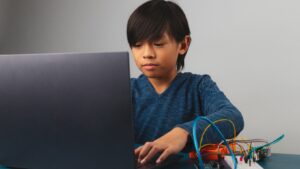In the ever-evolving world of technology, coding has become an essential skill for the next generation. Scratch programming stands out as a brilliant starting point for young minds eager to delve into the world of computer science. Designed by MIT, Scratch offers a user-friendly platform where kids can learn the fundamentals of programming through interactive, block-based coding.
Embarking on this coding adventure promises to open doors to creativity and innovation, providing kids with the tools they need to succeed in a digital age. Scratch programming is more than just coding—it’s a stepping stone to endless possibilities.
Scratch Programming For Beginners: A Kid’s Guide to Coding Fundamentals
 Scratch originated at the Massachusetts Institute of Technology’s (MIT) Media Lab in 2003. Designed by Mitchel Resnick, John Maloney, and several others. this innovative tool aimed to simplify the process of learning programming for young learners. It introduced children to the complexities of coding through a more accessible, visual programming language. Scratch was publicly released in 2007 and since then, it has consistently evolved. The platform, rooted in educational theory, prioritizes learning through design and creativity, enabling kids to explore fundamental programming concepts while undertaking playful projects that motivate learning.
Scratch originated at the Massachusetts Institute of Technology’s (MIT) Media Lab in 2003. Designed by Mitchel Resnick, John Maloney, and several others. this innovative tool aimed to simplify the process of learning programming for young learners. It introduced children to the complexities of coding through a more accessible, visual programming language. Scratch was publicly released in 2007 and since then, it has consistently evolved. The platform, rooted in educational theory, prioritizes learning through design and creativity, enabling kids to explore fundamental programming concepts while undertaking playful projects that motivate learning.
Key Features of Scratch
 Scratch offers numerous features that make it an ideal introduction to programming for children:
Scratch offers numerous features that make it an ideal introduction to programming for children:
- Block-Based Coding: Instead of typing complex code, kids utilize drag-and-drop graphical blocks to build scripts. These blocks, categorized by functions like loops, operators, and control structures, visually represent software coding principles, simplifying understanding for first-time programmers.
- Interactive Learning Environment: Scratch provides an immediate feedback loop. Children can see the effects of changes to their code instantly, which greatly aids in understanding and troubleshooting their scripts.
- Multimedia Integration: Users can incorporate sounds, images, and videos to make interactive stories, games, and animations. This incorporation keeps engagement levels high and fosters a deep interest in continuing to explore programming concepts.
- Community and Sharing: With millions of projects available for viewing and remixing, Scratch boasts a vibrant community. Kids learn by observing the work of their peers, gain inspiration from global contributions, and improve their own projects with crowd-sourced feedback.
These features ensure that Scratch remains appealing and educationally rich, providing a comprehensive platform where children can gain essential skills for the digital future.
Why Scratch Is Great for Kids
Visual Learning and Drag-and-Drop Coding
 Scratch utilizes an innovative visual programming interface that makes it much easier for beginners, especially children, to grasp coding concepts. The platform operates on a drag-and-drop mechanic where students can connect coding blocks to form functional scripts. This method eliminates the need for typing code, which can be daunting and prone to errors. By visually piecing together blocks, kids learn coding logic and structure in a way that’s intuitive and aligned with their learning capabilities.
Scratch utilizes an innovative visual programming interface that makes it much easier for beginners, especially children, to grasp coding concepts. The platform operates on a drag-and-drop mechanic where students can connect coding blocks to form functional scripts. This method eliminates the need for typing code, which can be daunting and prone to errors. By visually piecing together blocks, kids learn coding logic and structure in a way that’s intuitive and aligned with their learning capabilities.
Moreover, this visual approach helps young learners understand the flow of programs and the impact of their actions immediately. If a child connects a series of blocks and the desired action doesn’t occur, they see the result straight away, making debugging a learning process rather than a frustration. This immediate feedback encourages experimentation and adjustment, which are key processes in learning.
Building Creativity and Logic
Scratch goes beyond mere coding; it fosters both creativity and logical thinking. With access to a variety of resources like graphics, sounds, and animation effects, children can create a wide range of projects—from simple stories to complex games and simulations. By integrating coding with multimedia elements, Scratch allows children to express themselves creatively while applying logical thinking to bring their ideas to life.
Children develop problem-solving skills naturally as they think critically about how to execute their creative ideas using logical building blocks. For example, to create a game, a child must consider the rules, player interactions, and outcomes, all of which require a logical framework. This balanced approach to coding and creativity not only keeps the learning process enjoyable but also ensures that kids are equipped with critical thinking skills that are essential for academic and professional success in any field.

